#phd programme 2017
Explore tagged Tumblr posts
Text
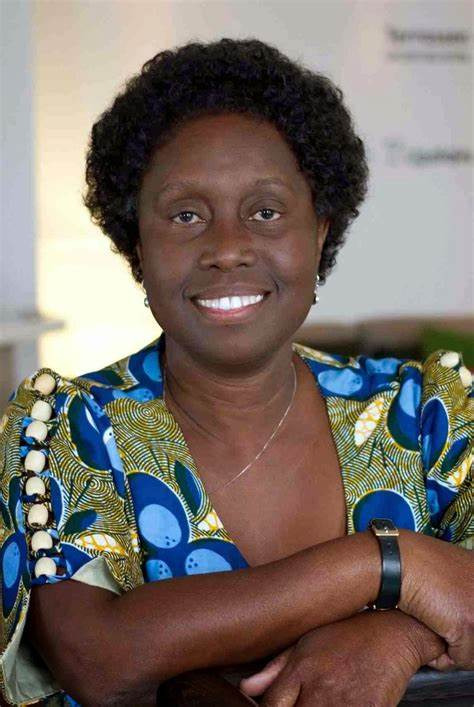

Notable Women In Zoology: Dr. Letitia Eva Takyibea Obeng
Dr. Obeng (1925-2023) was the first Ghanaian woman to obtain a degree in zoology, and the first to be awarded a doctorate. She is described as "the grandmother of female scientists in Ghana".
Her other notable accomplishments include:
A Bachelor of Science in Zoology and Botany (1952), a Master of Science in Parasitology (1962) and a PhD in Tropical Medicine (1964) where she studied the black fly and its relevance to river blindness
Post university, she lectured at the University College of Science and Technology (now known as Kwame Nkrumah University of Science and Technology, KNUST) from 1952 to 1959
In 1952, Dr. Obeng became the first female scientist at KNUST
After her husband's death in 19659, she moved to the the Council for Scientific and Industrial Research (CSIR)
IN 1964, she established the Institute of Aquatic Biology within CSIR to research the huge manmade Volta Lake in Ghana and its inland water system
Dr. Obeng was the first scientist to be employed by the National Research Council of Ghana
In 1965, Dr Obeng became a fellow of the Ghana Academy of Arts and Sciences. In 2006, she became the first female president of the Academy
In 1972, Dr. Obeng delivered the Caroline Haslett Memorial Lecture to the Royal Society for the Encouragement of Arts, Manufactures and Commerce, titled “Nation Building and the African Woman”
In 1972, she was an invited participant in the United Nations Human Environment Conference in Stockholm
In 1974, she began work as the Officer in the United Nations Environment Programme (UNEP), and in 1989, she became the Director of the UNEP Regional Office for Africa, and the UNEP's Representative to Africa
From 1992 to 1993, Obeng was a Distinguished International Visitor fellow at Radcliff College
In 1997, she received the CSIR Award for Distinguished Career and Service to Science and Technology, the first woman to receive such an award
The CSIR Laboratory (known as The Letitia Obeng Block) was named after her in 1997 as well
She received Ghana's highest national award, Order of the Star of Ghana in 2006
In 2017, she received an honorary Doctor of Science degree from KNUST
She was also the author of numerous publications and works. Two meant for the public were Parasites, the Sly and Sneaky Enemies inside You (1997) and -Anthology of a Lifetime (2019)
167 notes
·
View notes
Text
Unlocking mRNA’s cancer-fighting potential
New Post has been published on https://thedigitalinsider.com/unlocking-mrnas-cancer-fighting-potential/
Unlocking mRNA’s cancer-fighting potential


What if training your immune system to attack cancer cells was as easy as training it to fight Covid-19? Many people believe the technology behind some Covid-19 vaccines, messenger RNA, holds great promise for stimulating immune responses to cancer.
But using messenger RNA, or mRNA, to get the immune system to mount a prolonged and aggressive attack on cancer cells — while leaving healthy cells alone — has been a major challenge.
The MIT spinout Strand Therapeutics is attempting to solve that problem with an advanced class of mRNA molecules that are designed to sense what type of cells they encounter in the body and to express therapeutic proteins only once they have entered diseased cells.
“It’s about finding ways to deal with the signal-to-noise ratio, the signal being expression in the target tissue and the noise being expression in the nontarget tissue,” Strand CEO Jacob Becraft PhD ’19 explains. “Our technology amplifies the signal to express more proteins for longer while at the same time effectively eliminating the mRNA’s off-target expression.”
Strand is set to begin its first clinical trial in April, which is testing a proprietary, self-replicating mRNA molecule’s ability to express immune signals directly from a tumor, eliciting the immune system to attack and kill the tumor cells directly. It’s also being tested as a possible improvement for existing treatments to a number of solid tumors.
As they work to commercialize its early innovations, Strand’s team is continuing to add capabilities to what it calls its “programmable medicines,” improving mRNA molecules’ ability to sense their environment and generate potent, targeted responses where they’re needed most.
“Self-replicating mRNA was the first thing that we pioneered when we were at MIT and in the first couple years at Strand,” Becraft says. “Now we’ve also moved into approaches like circular mRNAs, which allow each molecule of mRNA to express more of a protein for longer, potentially for weeks at a time. And the bigger our cell-type specific datasets become, the better we are at differentiating cell types, which makes these molecules so targeted we can have a higher level of safety at higher doses and create stronger treatments.”
Making mRNA smarter
Becraft got his first taste of MIT as an undergraduate at the University of Illinois when he secured a summer internship in the lab of MIT Institute Professor Bob Langer.
“That’s where I learned how lab research could be translated into spinout companies,” Becraft recalls.
The experience left enough of an impression on Becraft that he returned to MIT the next fall to earn his PhD, where he worked in the Synthetic Biology Center under professor of bioengineering and electrical engineering and computer science Ron Weiss. During that time, he collaborated with postdoc Tasuku Kitada to create genetic “switches” that could control protein expression in cells.
Becraft and Kitada realized their research could be the foundation of a company around 2017 and started spending time in the Martin Trust Center for MIT Entrepreneurship. They also received support from MIT Sandbox and eventually worked with the Technology Licensing Office to establish Strand’s early intellectual property.
“We started by asking, where is the highest unmet need that also allows us to prove out the thesis of this technology? And where will this approach have therapeutic relevance that is a quantum leap forward from what anyone else is doing?” Becraft says. “The first place we looked was oncology.”
People have been working on cancer immunotherapy, which turns a patient’s immune system against cancer cells, for decades. Scientists in the field have developed drugs that produce some remarkable results in patients with aggressive, late-stage cancers. But most next-generation cancer immunotherapies are based on recombinant (lab-made) proteins that are difficult to deliver to specific targets in the body and don’t remain active for long enough to consistently create a durable response.
More recently, companies like Moderna, whose founders also include MIT alumni, have pioneered the use of mRNAs to create proteins in cells. But to date, those mRNA molecules have not been able to change behavior based on the type of cells they enter, and don’t last for very long in the body.
“If you’re trying to engage the immune system with a tumor cell, the mRNA needs to be expressing from the tumor cell itself, and it needs to be expressing over a long period of time,” Becraft says. “Those challenges are hard to overcome with the first generation of mRNA technologies.”
Strand has developed what it calls the world’s first mRNA programming language that allows the company to specify the tissues its mRNAs express proteins in.
“We built a database that says, ‘Here are all of the different cells that the mRNA could be delivered to, and here are all of their microRNA signatures,’ and then we use computational tools and machine learning to differentiate the cells,” Becraft explains. “For instance, I need to make sure that the messenger RNA turns off when it’s in the liver cell, and I need to make sure that it turns on when it’s in a tumor cell or a T-cell.”
Strand also uses techniques like mRNA self-replication to create more durable protein expression and immune responses.
“The first versions of mRNA therapeutics, like the Covid-19 vaccines, just recapitulate how our body’s natural mRNAs work,” Becraft explains. “Natural mRNAs last for a few days, maybe less, and they express a single protein. They have no context-dependent actions. That means wherever the mRNA is delivered, it’s only going to express a molecule for a short period of time. That’s perfect for a vaccine, but it’s much more limiting when you want to create a protein that’s actually engaging in a biological process, like activating an immune response against a tumor that could take many days or weeks.”
Technology with broad potential
Strand’s first clinical trial is targeting solid tumors like melanoma and triple-negative breast cancer. The company is also actively developing mRNA therapies that could be used to treat blood cancers.
“We’ll be expanding into new areas as we continue to de-risk the translation of the science and create new technologies,” Becraft says.
Strand plans to partner with large pharmaceutical companies as well as investors to continue developing drugs. Further down the line, the founders believe future versions of its mRNA therapies could be used to treat a broad range of diseases.
“Our thesis is: amplified expression in specific, programmed target cells for long periods of time,” Becraft says. “That approach can be utilized for [immunotherapies like] CAR T-cell therapy, both in oncology and autoimmune conditions. There are also many diseases that require cell-type specific delivery and expression of proteins in treatment, everything from kidney disease to types of liver disease. We can envision our technology being used for all of that.”
#Alumni/ae#approach#Behavior#bioengineering#Bioengineering and biotechnology#Biological engineering#Biology#blood#breast cancer#Cancer#cancer cells#cell#cell therapy#cell types#Cells#CEO#challenge#change#Companies#computer#Computer Science#covid#Database#datasets#deal#Disease#Diseases#drug development#drugs#easy
7 notes
·
View notes
Text
Epistemic injustice, healthcare disparities and the missing pipeline: reflections on the exclusion of disabled scholars from health research
People with disabilities are subject to multiple forms of health-related and wider social disparities; carefully focused research is required to inform more inclusive, safe and effective healthcare practice and policy. Through lived experience, disabled people are well positioned to identify and persistently pursue problems and opportunities within existing health provisions that may be overlooked by a largely non-disabled research community. Thus, the academy can play an important role in shining a light on the perspectives and insights from within the disability community, and combined with policy decisions, these perspectives and insights have a better opportunity to become integrated into the fabric of public life, within healthcare and beyond. However, despite the potential benefits that could be yielded by greater inclusivity, in this paper we describe barriers within the UK academy confronting disabled people who wish to embark on health research. We do this by drawing on published findings, and via the lived experience of the first author, who has struggled for over 3 years to find an accessible PhD programme as a person with energy limiting conditions who is largely confined to the home in the UK. First, we situate the discussion in the wider perspective of epistemic injustice in health research. Second, we consider evidence of epistemic injustice among disabled researchers, focusing primarily on what philosophers Kidd and Carel (2017, p 184) describe as ‘strategies of exclusion’. Third, we offer recommendations for overcoming these barriers to improve the pipeline of researchers with disabilities in the academy.
0 notes
Text
On this day in Wikipedia: Monday, 22nd April
Welcome, witamy, mirë se vjen, velkommen 🤗 What does @Wikipedia say about 22nd April through the years 🏛️📜🗓️?
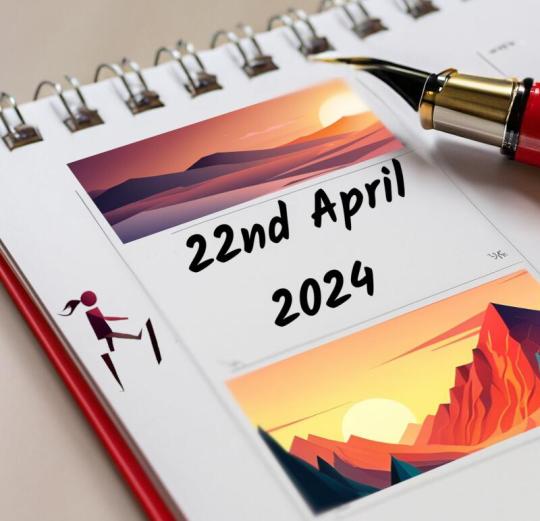
22nd April 2023 🗓️ : Death - Len Goodman Len Goodman, English ballroom dancer and television personality (b. 1944) "Leonard Gordon Goodman (25 April 1944 – 22 April 2023) was an English professional ballroom dancer, dance teacher, and dance competition adjudicator. He appeared as head judge on the UK television programme Strictly Come Dancing, where various celebrities compete for the glitter ball trophy, from..."
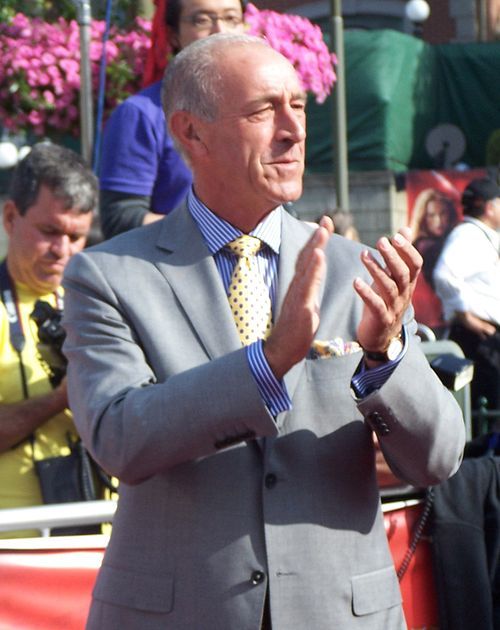
Image licensed under CC BY-SA 3.0? by alotofmillion
22nd April 2017 🗓️ : Death - Donna Williams Donna Leanne Williams, Australian writer, artist, and activist (b. 1963) "Donna Leanne Williams, also known by her married name Donna Leanne Samuel and as Polly Samuel (born Donna Keene; 12 October 1963 – 22 April 2017), was an Australian writer, artist, singer-songwriter, screenwriter, and sculptor. In 1965, aged two, Williams was assessed as "psychotic". During the..."
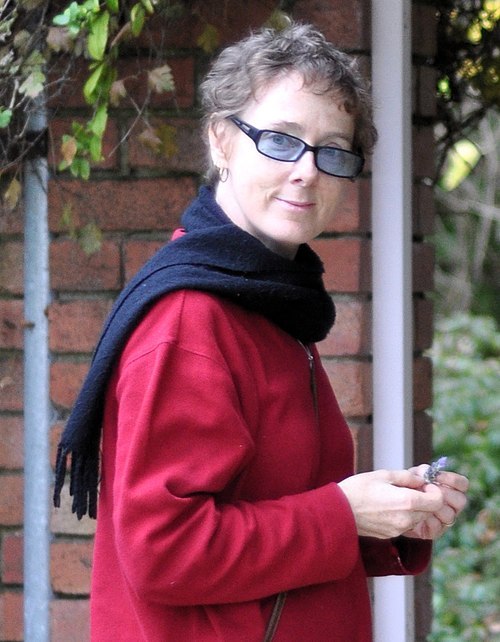
Image licensed under CC BY 2.0? by Chris Samuel
22nd April 2014 🗓️ : Death - Oswaldo Vigas Oswaldo Vigas, Venezuelan painter (b. 1926) "Oswaldo Vigas (August 4, 1923 – April 22, 2014) was a Venezuelan artist, best known as a self-taught painter and muralist. His work includes paintings, sculptures, prints, drawings, ceramics and tapestries. He worked in France and Venezuela. He had over one hundred solo exhibitions, and is..."
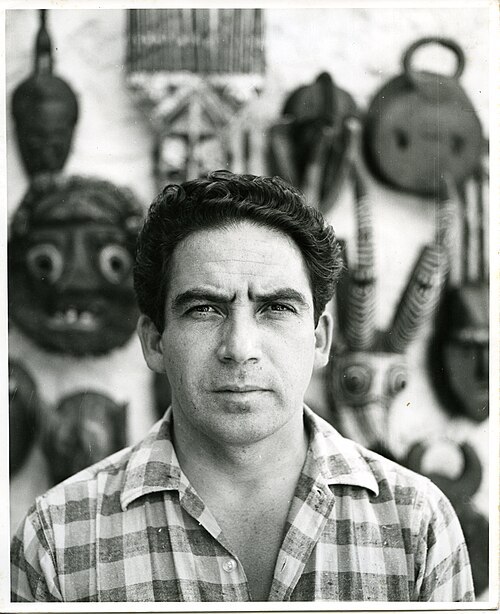
Image licensed under CC BY-SA 4.0? by Dilia1510
22nd April 1974 🗓️ : Event - Pan Am Flight 812 Pan Am Flight 812 crashes on approach to Ngurah Rai International Airport in Denpasar, Bali, Indonesia, killing all 107 people on board. "Pan Am Flight 812 (PA812), operated by a Pan American World Airways Boeing 707-321B registered N446PA and named Clipper Climax, was a scheduled international flight from Hong Kong to Los Angeles, California, with intermediate stops at Denpasar, Sydney, Nadi, and Honolulu. The airplane briefly..."
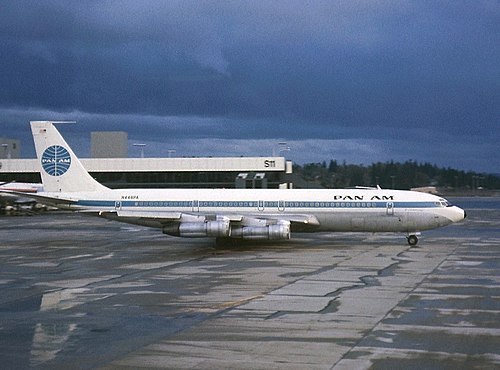
Image licensed under CC BY 2.0? by Bob Harrington
22nd April 1924 🗓️ : Birth - Nam Duck-woo Nam Duck-woo, South Korean politician, 12th Prime Minister of South Korea (d. 2013) "Nam Duck-woo (22 April 1924 – 18 May 2013) was the 12th prime minister of South Korea from 1980 to 1982. Nam received his PhD in economics from Oklahoma State University. He served as finance minister from 1969 to 1974 under the presidency of Park Chung-hee. He was appointed as Deputy Prime Minister..."
22nd April 1821 🗓️ : Death - Gregory V of Constantinople Gregory V of Constantinople, Greek patriarch and saint (b. 1746) "Gregory V (Greek: Γρηγόριος; 1746 – 22 April 1821), born Georgios Angelopoulos (Γεώργιος Αγγελόπουλος), was Ecumenical Patriarch of Constantinople from 1797 to 1798, from 1806 to 1808, and from 1818 to 1821. He was responsible for much restoration work to the Patriarchal Cathedral of St George,..."
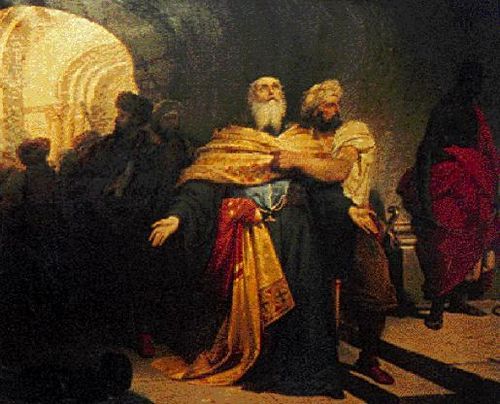
Image by Nikiforos Lytras
22nd April 🗓️ : Holiday - Christian feast day: Arwald "Arwald (died 686 AD) was the last King of the Isle of Wight and last pagan king in Anglo-Saxon England. ..."
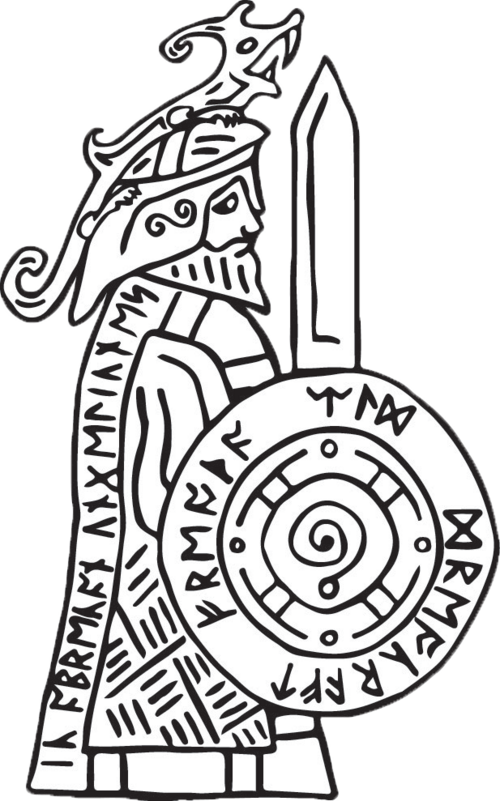
Image licensed under CC BY 4.0? by Paul A.T. Wilson
0 notes
Text
Journey IIMB - Part 1
Year 2017 Oct :Got placed
Year 2018 Jun : Joins work
2018 onwards: kelsa eno sigtu.pretty well paying job. innu enaadru doddadu maadbekalla.. what to do? Let's figure out while working.
By 2019…
*Badly frustrated about the IT culture. Negligent eating habits, drinking habits 🤮.
Eww! This shitty culture. I don't want to continue here. Just want get lost and out of this!
To worsen this, health starts deteriorating, life losses of close people*
Maybe ISRO? DRDO? Reads things on Quora, pretty irritated! NAH! You get stuck into the system and get into the circles of a typical sluggish govt job.
So what? Govt job is peaceful ! Let's give it a try to ISRO scientist
*Badly fails 🥲*
Let's write Railway Exams
*Pathetically fails 🥵*
Maybe, not my cup of tea. What's common to all these ? GATE
Haa ! GATE se yaad aaya . People also opt go for Higher studies. I am either doing it in a premium institute or not doing it.
Wait… Three options i know of :
Go to a foreign country to study (Chancey illaa, no wayy!)
M.B.A ( WHAT'S THE COURSE FEE😲? SOOO COSTLY? Nonsense!! And people ussually do this to become managers. Paapa! MANAGERgala Naayi padu nodakke aagtilla illi 🤣. Beda idu)
M.Tech (Hmm. Technology thrills me. I have started loving Datascience . It's an ocean. I am not getting bored at all. Let's do some masters in this. Changing domain now makes no sense)
*Agressively reaches out to people and starts researching. Decides I myself will take the decision about my education this time. (Why? Big story! Adella weekend with Ramesh ge irli 😜)*
Ok . After a patent in work , let's leave the job, join some coaching centre and prepare for GATE .. M.Tech … Lecturer in some college .. life settle 😃🙃😀💭💭. Ahaa .kanse esht chenaagide
Year 2020 - * Boom 💥 CORONA. LOCKDOWN 💥 💥 💥 . NEVER KNOW WHEN EVERYTHING WILL BE NORMAL AGAIN… EVERYTHING ONLINE … ***
Damn! 😓. Ella plan ulta pulta. Not an online material... Let's study on own.
*Orders study materials. Starts preparing very seriously waking up at 4am and all 😮😮😮😮*
Very soon started burning out. Too much work pressure. Challenging family situations. Multiple lockdowns, no moving out , no stress release anyway!
At some point , it made me think. I am struggling to study what I studied for 4 years. To study for 2 more years. After this too , there's no guarantee of a lecturer job . You need a PhD. 5 more years. To finally earn the same salary i would be earning even if I continued in the same job. Nah! Not making sense for the kind of efforts i am putting. Also, even if i take all these risks and join an IIT, have to stay in the hostel. Eat veg , non-veg hostel's food for 2 years. Compromising food? Nah ! Let's drop the idea of masters. This is also not my cup of coffee , maybe🥲🥲!
*Yavdaadru olle college alli (IIT/IIIT/NIT) alli non-residential course iddu, Mane indane hogo thara degree programme irbaada? Che! Ivella imagination ashte antaddu yaavdu illa. Bidu! Masters beda 😓*
*Didn't even write GATE that year*
But wait, some good thing in life happened.
Music!! Cleared junior exams that year. Chalo life mai kuch toh aim ka accomplishment hua! Continued music
0 notes
Text
Trans- States
LUCY A. SAMES
PhD Candidate / Associate Lecturer, Goldsmiths, University of London
Wet Rest: Speculative Ontologies of Floatation
Lucy A. Sames is a curator and researcher living and working in London. She is an Associate Lecturer in Visual Cultures at Goldsmiths, University of London and holds a PhD studentship at Northumbria University Newcastle (2016-19) where her research project SYBRNTCKMYSTX utilises mystical diagramming as a technology for analysing the intersection of cybernetics and altered states of consciousness as manifest in contemporary art practice and curating. This stems from 5 years of related exhibition making: Janusware (Res. London 2017), CHEMHEX EXTRACT (PVA Aberdeen 2016), Exta (Res. London 2015), Tomb Shrine (Enclave London 2014) and Sci-Fi Paganism (Enclave London 2013).
Lucy is Co-Director and Curator at Res. (www.beingres.org) a mutable project based in a gallery and workspace in Deptford, South London, where their recent co-curated cross-platform programme Alembic (Res. London 2016-18) considered the legacies of cyberfeminism through processes of alchemical transmutation, and included archival work, international artist commissions, performance, an online commission, book and conference.
She is part of the Social Morphology Research Unit at University College London, where her interdisciplinary collaborative work concerns the cumulative constitution of personhood through ‘altered states of consciousness’, and utilises practices of both anthropological and artistic research.
1 note
·
View note
Text
PGDM Colleges in India

Best PGDM Colleges in India
ABBSSM (the Indian Business School) is a top B-School in India that offers a PGDM in Business Analytics Bangalore. This institute ranks among the 21st best B-Schools in the world, which is a testament to the quality of education it provides. Besides its renowned B-School status, the college also has a number of knowledge partners, which is a sign of an institution that is able to deliver value to its students.
ABBSSM offers a PGDM in business analytics course
Business analytics is a practice in which companies use systematic exploration of data to discover trends and improve their performance. Today, businesses have access to vast amounts of data generated from every digital purchase, website visit, and Facebook posting. This information is then analyzed to generate actionable insights.
To conduct this process effectively, business analysts need to have strong communication and analytical skills. They must also be able to work with clients in different departments. In addition, they must be able to respond quickly to challenges and hurdles.
Many colleges now offer a specialization in business analytics, which can be combined with an MBA. There are also many companies that recruit PGDM Business Analytics graduates. Among them are Wipro, Accenture, and Deloitte.
ABBSSM ranks 21st Outstanding B-Schools of Excellence
If you are looking for a reputed PGDM Colleges in Bangalore, you can't go wrong with ABBSSM. It is one of the top business institutions in the city. The school has a campus that is well-equipped with various facilities. Moreover, the students are given a variety of scholarships based on merit and social awareness.
ABBSSM is accredited by the National Assessment and Accreditation Council. Besides, the institute has a host of collaborations with other universities and corporations. There are three computer labs that provide practical experience in various academic disciplines.
Besides, ABBSSM has a dedicated placement cell that organizes different programs. Additionally, the institute is involved in international partnerships with many universities. For instance, the institute has a joint venture with Punjab National Bank.
ABBSSM offers a structured study program
The Acharya Bangalore Business School of Management (ABBSSM) has a structured study program for Post Graduate Diploma in Management (PGDM) students. It is a two-year course that aims to give students a comprehensive understanding of business principles. Besides, the program includes practical and experiential/live projects, which aim to provide students an insight into real-world corporate realities.
This institute has received several prestigious accreditations, including Silicon India's Business School of the Year. In 2017, it was awarded the Business School of the Year for Teaching Excellence by Academic Insights.
ABBSSM's faculty includes eight professors, who have PhDs. These experts in their fields help students in their academic and professional careers. They are also well-experienced and have rich industry backgrounds.
ABBSSM offers a range of PGDM courses. Among them, PGDM International Business is the latest addition to its list of innovative courses. The course provides training on various international business systems and methods.
ABBSSM has knowledge partners
The Post Graduate Diploma in Management course is one of the most sought-after degrees in India. It is a two-year diploma programme that focuses on practical management knowledge and the functioning of a business organisation. This PGDM Bangalore course prepares students for the dynamic corporate environment and emphasizes a desire to work with people.
ABBSSM offers a number of PGDM courses in various specializations. These PGDM Global courses are offered under the supervision of experienced and qualified faculty. Besides, ABBSSM also has a dedicated placement cell that helps in improving student knowledge and skills.
ABBSSM is a well-reputed business school that has received immense appreciation from the education industry. Moreover, its faculty are among the most competent and qualified individuals in the country. They play a vital role in imparting quality education.
GIBS B-School Bangalore is the first IRE college in India
The Global Institute of Business Studies (GIBS) is one of the best B-Schools in India. This university is affiliated to Bangalore University and is certified by the All India Council for Technical Education (AICTE).
GIBS offers a PGDM programme. During the program, students are trained in innovation, research and entrepreneurship.
A PGDM course in GIBS is a two-year full-time programme. Students are also required to complete internships. In addition to internships, GIBS has a proven track record of arranging placements for its students.
GIBS has over 600 partnerships and has a good history of placements. It is also known for its international education system and has a well-experienced faculty team.
As part of the Careers360 marketing initiative, GIBS has an IRE lab that enables students to carry out real-world research. They are trained in entrepreneurship and innovation, which are essential for success in business.
0 notes
Text
How To Cope When Your Life Changes Irrevocably, Dramatically and Completely But In An Instant
Vajrin Malin qualified as a doctor from Bristol Medical School in 1985. His postgraduate medical training was mostly in London, initially in Infectious Diseases. This took him to a lecturer position in Zimbabwe for two years where he had an interest in TB in HIV. He then undertook a PhD on TB vaccine design and finally completed his training including Infectious Diseases, Respiratory and General Medicine. He recently retired from 20 years as Respiratory Consultant in Bath. He's had a lifelong interest in training and education. In addition to his time in Africa, he was College Tutor for the Royal College of Physicians, Foundation Programme Director, Director of Medical Education in his hospital trust and Associate Postgraduate Dean for Health Education England (HEE) South West. He sat on the council for the NACT UK holding the office of Honorary Treasurer then Honorary Secretary. His HEE responsibilities included providing professional support for postgraduate trainees (PSW) and Supported Return to Training (SuppoRTT). He's taught in Uganda, he has been a NACT Eugene Meyer Travelling Fellow to North Carolina and written several documents for NACT. He was a keen triathlete competing in Ironman events, marathons and long distance cycle holidays with his wife and friends. He was ordained and given the name Vajrin (previously Adam) in the Western Buddhist Order (now Triratna) 16 years ago.
Sadly, in February 2020, whilst undertaking a 3000km off-road cycle trip the length of New Zealand, he fell 20m down the gorge leaving him permanently paralysed from his chest down. However, he's had excellent rehabilitation, initially in Auckland and later Salisbury and Stoke Mandeville spinal units. After a stormy period in the first year of his spinal cord injury (four neurosurgical operations for a swollen spinal cord - SPAM). He is now back working one day a week for HEE seeing trainees and running a South West programme on supporting trainees who’ve had a break of 3 months or more. His interests include health and well-being, coaching (ILM5 trained), burnout, educational leadership and educational systems.
Selection of articles
Supporting Locally Employed Doctors (LEDs) across the UK: The non-consultant non-training doctors. NACT UK 2017 (currently being updated)
Putting an end to Black Wednesday: improving patient safety by achieving comprehensive trust induction and mandatory training by day 1 - Clinical Medicine 2016
Vaccinia expression of mycobacterium tuberculosis antigen 85 and ESAT-6 secreted proteins - Microbes Infect. 2000
Pneumocystis carinii pneumonia in Zimbabwe - Lancet 1995
Leprosy in reaction: a medical emergency. Lesson of the Week - British Medical Journal 1991
Check out this episode!
2 notes
·
View notes
Text
Emblem Of A Better Germany?
In 2014, at the 14th Venice Architecture Biennial, Alex Lehnerer and Savvas Ciriacidis placed the armoured limousine once used by then Federal Chancellor Helmut Kohl in front of the German Pavilion.
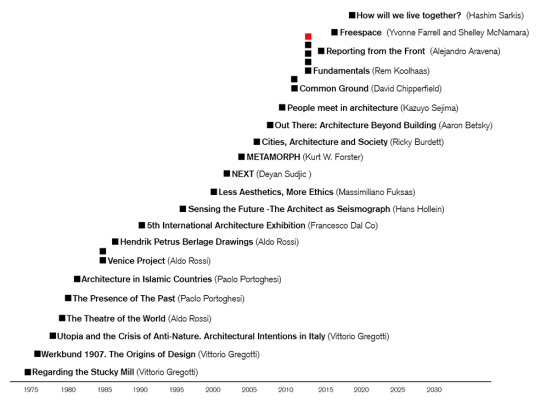
Read also “The Invisible Church”, “What Fundamentals? Revisiting Treasures in Disguise: The Ominous Ruins of Montenegrin Modernism” and “The Greek Experiment”
It was a black Mercedes-Benz car with its famous star that added the air of a different era, the Federal Republic of Germany before the fall of the Wall, when its capital was Bonn on the Rhine River in West Germany, and not Berlin. Placed before the steps of the monumental façade of the German pavilion, once build as the Bavarian pavilion and then decisively altered by Nazi Germany in 1938, every German visitor would read this car as a sign, an emblem of what came to be known as “Made in Germany”, high quality cars, machines, and other industrial goods that were seen as responsible for the so-called “Wirtschaftswunder” (economic miracle) after WWII, the economic rebuilding of West Germany.
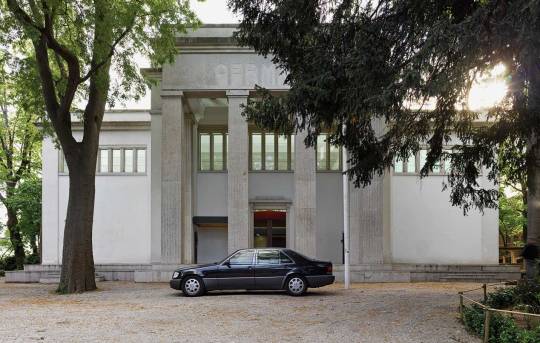
On the one hand, this car is a desirable object, vintage and expensive. In my family, you knew you had made it when you could afford a Mercedes-Benz. You could tell, when my parents bought their first Mercedes-Benz, they were full of pride. And they still drive the same car and feel the same way about it, although now it’s a rather old car.
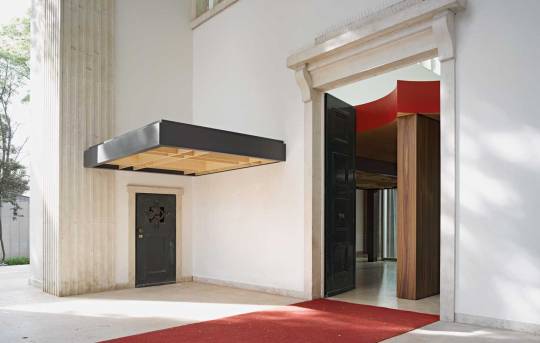
On the other hand, you could also read the continuities of 20th century German history into this juxtaposition of car and pavilion. Because what is the link between the Nazi façade and the later car? You might answer this question with the seamless integration of Nazis in German politics and business and the financial gains of many German companies (including Daimler-Benz) during the Nazi period thanks to forced labor, expropriation, and simple opportunism. The juxtaposition places you, at least as a German, between guilt and pride, haunting memories and desire.
Adjacent to the left of the big front door of the German pavilion in Venice, the visitor was greeted by an elegant section of a roof jutting out above a much smaller door. It was a hint that the interior of the pavilion was taken over by another structure, a partial replica of the former Chancellor’s residence in the former capital of the country formerly known as West Germany. A somewhat nostalgic remnant of a bygone past, a country and political system that were fundamentally altered by the fall of the Berlin Wall and the reunification of Germany. It was the Germany I was born into, with Bonn being the capital until 1999 and the Chancellor’s residence – or Kanzlerbungalow (‘Chancellor’s bungalow’) – constantly in the news. As much as it was nostalgic, Lehnerer and Ciriacidis’ pavilion had an uncanny feeling to it. Inside and outside were suddenly called into question, different times collapsed into each other, with the democratic bungalow inserted into the Nazi pavilion. Or was the story told more complex than that, as with the car parked in front of the pavilion? The story was, for sure, one about architectural representation.

The Chancellor’s bungalow was built in 1964 by the architect Sep Ruf for Ludwig Erhard, the second Chancellor of West Germany. Erhard was the German politician who stood like no other for the ‘economic miracle’ of West Germany after WWII. As the Federal Minister of Economic Affairs under Chancellor Konrad Adenauer from 1949 until 1963, when he became Chancellor himself for three rather unlucky years, he promoted what he termed the social market economy and gained widespread popularity with this economic concept. Although Erhard worked for the German state as an economist during the war, he rejected Nazism and was in contact with members of German resistance groups. It seems fitting therefore that as Chancellor he hired the fellow Bavarian Sep Ruf to design the new Chancellors residence in Bonn. Ruf was known for his functional designs in the tradition of the Bauhaus and older modern architects, who had mostly emigrated during the 1930s, like Ludwig Mies van der Rohe. Ruf’s elegant bungalow in Bonn payed homage to designs of the Bauhaus and Mies in particular. The latter’s Barcelona Pavilion, the German Pavilion at the 1929 International Exposition in Barcelona, has often been mentioned as a reference.
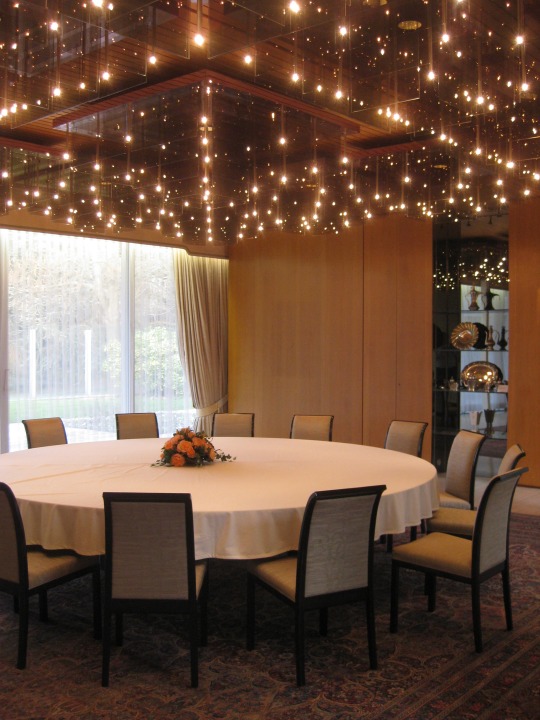
Dining room of the bungalow of the Chancellor in Bonn.
By 1964, Ruf had already worked for the federal government several times. Together with another modernist architect of the postwar period, Egon Eiermann, he had for example built the German pavilion for the world fair in Brussels in 1958. He was, thus, well informed about West Germany’s representational needs. The Chancellor’s bungalow spoke not only of the Bauhaus and the better, modern Germany that was supposed to be represented by buildings in its tradition like those of Ruf, Eiermann and others, but it also established a clear link to modern architecture internationally. Looking at the bungalow, some might be reminded of the famous Case Study Houses at the West Coast of the USA. After all, it was the declared aim of West German politicians to make the Federal Republic part of the Western political sphere (‘Westbindung’, or policy of the alignment with the West). I would guess that these two aspects, the tradition of a better, modern Germany and the alignment with the West, were first and foremost represented by Ruf’s bungalow in Bonn.
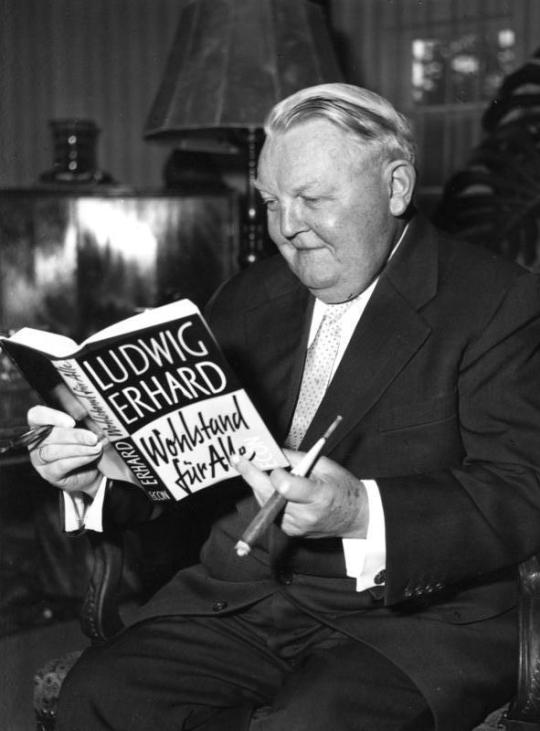
The second Chancellor of Germany, Ludwig Erhard.
The third Chancellor, Kurt Georg Kiesinger, took over from Ludwig Erhard in 1966. He was a former member of the NSDAP and disliked the Chancellor’s bungalow for its functional, ‘cold’ design. He had many things altered before he moved in and brought with him antique furniture pieces in stark contrast with Ruf’s modern architecture. Most of the other Chancellor’s after him agreed with Kiesinger’s view on their official residence. They were looking for something more comfortable and cosy (gemütlich). Under Chancellor Helmut Kohl the interiors had changed so fundamentally that it was hard to still see Ruf’s designs behind thick layers of carpet and bulky sofas and chairs. Not to speak of the new 1980s glittery lighting. Although partly preserved in the original building in Bonn, these alterations, additions and layers were not present in Venice.

Prince Philip, Queen Elizabeth II and the ex-Chancellor of Germany Helmut Kohl front of the bungalow of the Chancellor in Bonn.
It was a clearer picture or juxtaposition that Lehnerer and Ciriacidis drew. Only the brief blaze of fire in the Chancellor’s fireplace could have been something of a reminiscence to the other, the not-so-modern, not-so-open, cosy Germany that gathered around home-and-hearth. The Germany I grew up in. Just like the Mercedes-Benz, a fireplace was something quite desirable for the generation of my parents. You had to have one. And now, decades later, my parents even installed a new one. As if you couldn’t or wouldn’t want to live without it. Herman Miller’s Eames Collection that Erhard chose for his initial version of the bungalow at the River Rhine might have always been too expensive for most Germans, but they also represented a certain idea of Germany, like the whole bungalow an internationally oriented, better Germany – and not necessarily the real one. I wonder, does the real, and not the ideal, ever get represented? It might be an interesting task for a future German pavilion at the VAB.
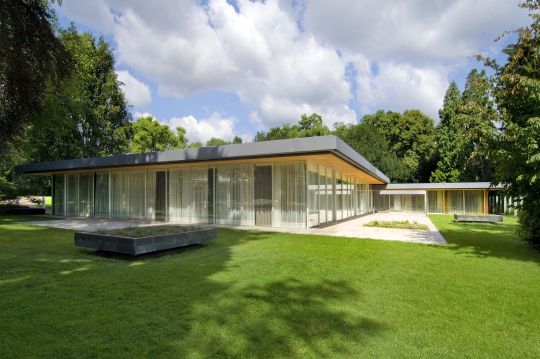
The bungalow of the Chancellor in Bonn.
West Germany claimed the Bauhaus as its heritage since the 1950s, through the founding of the Bauhaus-Archiv in Darmstadt in 1960, countless exhibitions and books and buildings seemingly in its tradition (there were similar efforts in the GDR a little later). 2019, the year of the centenary of its founding, saw the Bauhaus at the height of its representational instrumentalization, it had become a major part of German cultural diplomacy. Yet, the Bauhaus has oscillated between national claims and International Style even before it was closed by the Nazis. This oscillating reception of the Bauhaus was crucial in making sure that the Bauhaus would continue to be productive until today. Looking back in 2020, the German Pavilion at the 14th VAB is also a vivid illustration of the complicated history of the Bauhaus and Germany.
***
VAB 06: Florian Strob
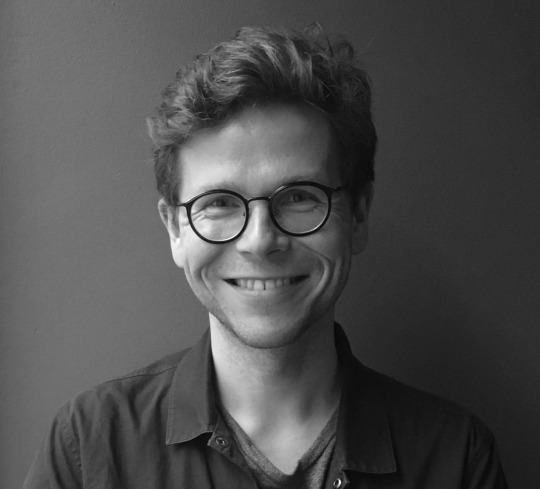
Florian Strob is an author and curator in the fields of architecture, literature and contemporary art. He holds a B.Sc. in Architecture from the Technical University in Berlin and a PhD in Medieval and Modern Languages from the University of Oxford. His main research interests are modern architecture, modern poetry and experimental prose, and the connections between built spaces and text. Florian currently works at the Bauhaus Dessau Foundation, where he curated the exhibit “Bauhaus Buildings Dessau: Originals retold”. For this, Dessau’s Bauhaus buildings, facades and interiors are on exhibit. They have been given a new and coherent narrative through an exclusive series of video clips which set historical images in motion using 2.5D animation. He also organized the international conference “Collecting Bauhaus” in December 2019. He is the head and curator for the Bauhaus residency programme 2020-2022, which invites artists and writers to live, work and exhibit in the historic Masters’ Houses in Dessau. The most recent exhibition in this series, “Gropius House || Fictional. Inge Mahn and Sujata Bhatt”, is on show until 20 September 2020. Most recently, Florian published “Bauhaus Dessau Architecture” (Hirmer 2019), including new photographs by Ostkreuz photographer Thomas Meyer. He is author, editor and contributor of several other books, including “Hiatus. Architekturen für die gebrauchte Stadt” (Birkhäuser 2017) and “Schreiben und Lesen im Zeichen des Todes. Zur späten Prosa von Nelly Sachs” (Winter 2016).
95 notes
·
View notes
Text
Studying and Living in a foreign country is everyone's dream. Studying abroad offers you wide experience and much more. But the massive tuition fee and other living expenses are always the deal breakers.
Nevertheless, there are certain countries that offer education free of cost or with nominal tuition fee to residents and international students.
1. Germany
When it comes to excellent higher education at minimal or no cost, Germany top the list.
2. Norway
Graduate, post graduate and doctorate level programs in Normal are absolutely free of cost regardless of your nationality. But they do have one requirement- you should be profient in Norwegian. So in case of apply, better start learning language right away!
3. Sweden
While Universities of Sweden do charge application fee and tuition fee from non members of EU, EEA and Nordic countries for graduate and post graduates programmes, they offer PhD position for no fee, in fact they get monthly salary! So, why don't you add the Dr. Prefix to your name in Sweden.
4. Austria
Non EU/EEA students will have to pay nominal tuition fee of around €730 per semester. Not bad, considering the quality of life, such a beautiful country it is.
5. Finland
Finland don't charge any tuition fee for any level of education or any Non EU/EEA students will have to pay nominal tuition fee of around €730 per semester. Not bad, considering the quality of life, such a beautiful country it is.. But from 2017, they have started charging tuition fee from non EU/EEA students for English taught Bachelor's and Master's programs.
6. Czech Republic
Higher education here is free for all nationalities. It's the law here. But for that you need to know the local language. And even if you want to study in English, a nominal fee of around $1,000 will suffice as tuition fee.
7. France
Higher education in France is mostly free, expect at some public universities. But then again, even that fee is pretty minimal.
8. Belgium
International students have to pay a minimal fee to study in Belgium, which doesn't pinch at all because you get to experience a totally different culture.
9. Greece
The land of God's, Greece offers low cost higher education to international students along with minimal cost of living as well.
10. Spain
Like other European countries, Spain too offers free education to EU citizens only. But it too offers low cost education to students outside EU and offer reasonable cost of Living.
#education#student#career#edtech#motivation#studentvisa#studyabroad#studyblr#student life#studentblr#studyvisa#educacion#europe#edteach#parenting#lifelessons#trending#important information#countries
4 notes
·
View notes
Text
How Sage University, Indore become most emerging University in central India.
By- Parul Verma
SAGE university i.e. SAGAR Group of Educational Society, is considered to be the best university in Bhopal and Central India, established in 2017 by an act of the state government of Madhya Pradesh. The governing body of SAGE University includes the board of Management with Er. Sanjeev Agarwal as Chairman, the academic Council and the finance committee.This prestigious university offers 131 undergraduate, postgraduate, diploma and PhD programmes across various multi-disciplinary institutes like Institute of Advance Computing, Institute of Commerce, Institute of design, science, journalism and mass communication, law and legal studies etc. SAGE university Indore follows project based learning for skill development of its students. It has been ranked as top private engineering institute (2020), 65th in India by the Times of India and the number one emerging university by Outlook (2020). This great University has been awarded several times including The Top University of Central India Award, the national Innovative Award, The Most promising group of MP Award. It offers up-to 100% scholarship and worth 2 crore scholarships have been disbursed by the university till date.
The campus of the university is well-built.The infrastructure of the university has increased a lot in the recent years. This university consists of a 4 floors building for both girls and boys, the cafeteria area of the university is also very vast and is divided into two parts, one for faculty and second for students. The SAGE has recently build a state-of-art auditorium with a capacity of 1500 seats. This university provides transportation facilities not only to the students but also to the staffs. This university is having various hobby clubs to keep everyone’s interests alive. The fee structure at this university is quite high in comparison to others, but the money is worth it.
The requirement of industry and that of academic education is growing in recent years and the SAGE University has developed its own academic model which bridges the gap between industry requirements and the academic education. In order to make your tomorrow better SAGE University provides every possible thing needed and here at stage there is a futuristic approach to fulfil everyone's dream. Living you dream life and achieving your goals needs an institution like SAGE.
Reference: https://sageuniversity.in
1 note
·
View note
Text
Why I’m Currently Not Writing
I want to write this post as a sort of personal reflection. But I am posting it on here because first of all, I like to share bits of my life on here and second of all (and more importantly) I’d like to get advice from some other writers on Tumblr! I know some of my followers are writers, but even if you aren’t following me (or maybe even if you aren’t a writer) I’d like to hear your thoughts.
So. Why am I not currently writing?
First of all, let me give you a bit of background really quickly: I knew that I wanted to write from when I was very little. As soon as I could write a few words, I started making these hand-drawn comics with speech bubbles. As soon as I could write properly, I hand-wrote my first novel, at age 8. From then on, I was almost constantly writing. I finished my first typed novel at age 12. Then the sequel at age 13. Then another novel at age 14. Then, I got kind of busy, especially with school. But after school, at age 18, I finished another novel.
Now that’s when the problems started. Yes, I got busy again, first on my gap year, then with uni. But essentially, from that last finished novel in 2014 on, I haven’t been able to finish anything. Wait, no, that’s not quite true, I haven’t been able to finish a novel. I went through an incredibly prolific phase in 2015/2016/2017, where I wrote lots of fanfiction and short stories with original, recurring characters. But from 2014 until now, I also started and abandoned 4 large writing projects (that were meant to be novels). I last worked on the last of these projects in October 2020. Then… I just got really busy with uni, lost interest… I’m not sure. I never officially abandoned it, but let’s just say… I’m not feeling particularly optimistic about this project getting finished at the moment.
Now as somebody who never had any issue finishing novels – as somebody who actually decided in her teens to never start a novel she couldn’t finish! – this is driving me wild. Throughout my teens, if I wanted to write a novel, I just… wrote it. I normally spent about half a year planning it. Then half a year getting it written. (I don’t have much practice editing my novels, but that’s an issue for another time.)
So. Why am I not currently writing? I’ve thought about it and I’ve come up with a few reasons.
1. Other things feel more important at the moment. I have other priorities. A really big personal goal of mine that is taking up a lot of time and even more mental energy is getting into a PhD programme/securing a PhD position, preferably at my local (prestigious! So hard to get into!) research institute. Writing a novel just seems… a lot less important compared to this goal at the moment. Getting good grades in another priority that seems more important than writing. As does working out. As does spending time with my boyfriend.
For a long time, I thought it was mostly this. The fact that I had different priorities. But upon reflection, I think there is even more to it than that:
2. I have progressed enough as a writer to now be hypercritical of my work, much more than I was before. I kept asking myself: “How was I able to simply finish things as a teenager? Why was I a better writer then than I am now??” Then I realised. I very likely wasn’t. I very likely was a much worse writer and therefore much happier to accept sloppy writing, bad plots and so on. Things that I no longer tolerate. Things that now make me abandon projects, because they just don’t seem good enough for me. I thought some more about the novels I finished writing as a teenager and realised… if I was writing them now, I would probably abandon them to! Those books had major flaws that weren’t as obvious to me then as they are now OR that I noticed, but was willing to ignore.
3. Related to the second point… my current writing goal is an extremely high one. I want to write a novel and get it traditionally published. This is no small feat. On the contrary, it’s kind of the holy grail of writing. If I feel like a project does not have what it takes to get traditionally published… I am very likely to abandon it. As a teenager, I think my major goal was to finish things. Primarily, writing was fun. Now, I am always writing with this very intimidating goal in mind and it’s making me have much higher standards for my own work.
4. I feel like as a writer I am currently in a phase of learning, processing, taking things in… I am reading more than ever, reading about writing more than ever, watching Masterclasses on writing… It feels like a time to soak things in, like a sponge, rather than a time for output (apart from academic output, which I am required to produce).
5. Related to that last point… I am not sure I have anything important to say. I kind of feel like I need to spend more time living, actually experiencing interesting things, forming opinions, finding messages that are important to me… It was something I became more aware of over the past few years: that it was just very hard for me to write adult characters in regular jobs, because I was a student and had never really worked a regular job like “nurse”, for example. The first project I abandoned was about a middle-aged mother of three and I just really quickly realised that I was in over my head. I’m sure that once I become a mother, I will have a lot of things to say about motherhood and will be able to write about it very realistically! But right now, I just can’t do that.
6. Building on the last point again… writing a novel and getting it traditionally published is starting to feel more and more like a life-time project. When I was younger, the goal was always to get published young. I wanted to get published during my teens, then during my early twenties. Now, I’m glad that that didn’t happen! Because what I could have written and published then is something that most likely I wouldn’t be proud of today. And more and more I want to wait until finally, at one point in my life, maybe really late, I write one thing that I am actually really proud of and that I want to be published under my name. (And yes, maybe your old work will always be cringey to you, but I strongly believe that there are degrees of cringe ranging from “I am a horrible person for putting this out into the world and I wish I could travel back in time” to “Okay, this sentence is kind of awkward and this plot point maybe wasn’t the best, but hey, it is what it is, I’m still proud of it overall”.)
So yeah, these are the reasons why I am not currently writing. My question now is… what should I do? Focus on short stories and/or fanfiction again? Try to force myself to finish one of my WIPs? Continue to just… take a break from writing? Try really hard to come up with something better and make a commitment to this new project…? Try to make it a priority, likely the expense of something else...?
Would be happy to hear any thoughts any of you had on this! Thank you so much in advance! <3
2 notes
·
View notes
Text

📚Welcome to my studyblr!📚
I've had this sideblog for quite some time but recently I decided to clear it empty and transform it into a phdblr/studyblr.
For those who already follow me but don't know me personally, I'm a linguistics phd candidate and I started my phd in 2016. My topic is voice-over translation within the field of audiovisual translation.
(some personal stuff is coming, if not interested, scroll down one paragraph)
Incidentally this has been the worst 4.5 years of my life: 3 months into the programme (2016) my father-in-law died and one month later a very dear friend of mine died as well. Also during these years I was diagnosed with Addison's disease (2017), treated for thyroid cancer (2018), had a gyno surgery (2019) and my mom's breast cancer came back (2019) . She died 12 days ago.
So you see it has been a tough couple of years. It is a wonder that I managed to tackle the three obligatory publications and all the required credits while dealing with the aforementioned personal/health stuff as well as working as a freelance translator and lecturer at several universities.
But now the deadline of my dissertation is closing in. I have roughly 100 days to complete it from scratch.
It is going to be an explorative dissertation, the main focus of it being genre analysis and the establishment of the terminology that doesn't exist or isn't unified within the field in Hungarian.
So basically the lit review will be very long and I will do a minor discourse analysis to identify tendencies that are unique to voice-over translation as opposed to dubbing.
My studyblr will serve as a way of keeping tab of my progress in the form of daily posts of a 100 days of productivity.
Today was day one aka 1/100. I've collected every literature I could take my hands on in these uncertain times (i. e. the libraries are closed).
If anyone wonders why tf they follow me already, my main blog is @wolvesandhoundshowltogether (fanfic writing, nsfw, thirst). Perhaps we know each other from there.
Here's to a 100 days of productivity! 📖
4 notes
·
View notes
Text
Materials World’s top feature of 2019
As 2019 is drawing to a close, the Materials World team wanted to highlight a couple of stories to end the year on a high note. On Wednesday we shared the news story that got the most clicks on our website in 2019. Today, we are sharing the top feature. We hope you enjoy and Merry Christmas from the editorial team.
15 UNDER 30
By: Idha Valeur
IOM3 is looking to the future and celebrating young talent and ambition. Idha Valeur talks to the ones to watch in STEM.
Kyle Saltmarsh Age: 27 Job: Robotics Engineer at Woodside Energy. Education: PhD Engineering in Submarine Vibration and Acoustics, BSc in Physics and Applied Mathematics, BME (Honours). Current project: Deployment of robotic technology onto Woodside’s oil and gas plant for surveillance, and performing tasks through robot manipulation. Achievements: Best honours thesis, several hackathon wins, top IBM 2018 graduate in Australia/New Zealand, 2018 Young Persons’ World Lecture Competition Winner, world’s largest bungee jumper, blogger and hosting a podcast to inspire people in technology. Ultimate goal: To positively impact the world through the power of technology.

Kyle Saltmarsh Image credit: Brent Campbell
Jennie Palmer Age: 26 Job: Research Engineer. Education: Undertaking an EngD in Structural Metals for Gas Turbine Applications, BEng in Aerospace Engineering, with a year in industry, Swansea University. Current project: I am researching the development of bespoke test facilities and fundamental understanding of thermo-mechanical fatigue crack growth behaviour in titanium alloys. Achievements: Graduating with a BEng in Aerospace Engineering with First-Class Honours, presenting my research at national and international conferences, having research published in an internationally recognised journal and a Green Belt Certificate in Lean Six Sigma. Ultimate goal: To become a well-established, technical expert in my engineering field.
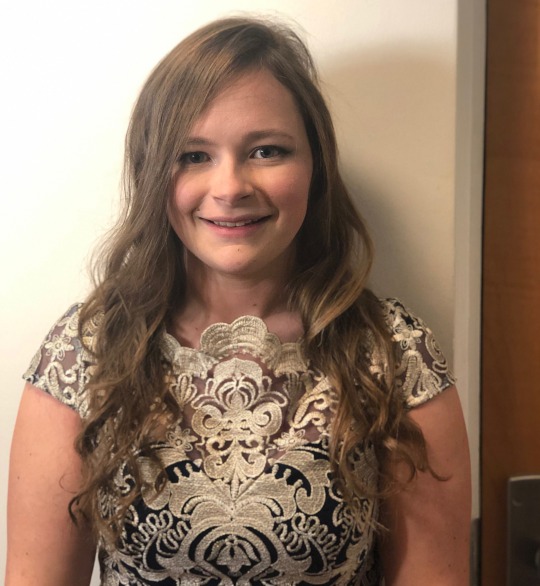
Jennie Palmer Image credit: Jemima Bond
Ilija Rašović Age: 27 Job: Lecturer at University of Birmingham Education: MEng in Materials Science at Corpus Christi College, Oxford. DPhil in Materials at St Cross College, Oxford. Current project: The use of fullerenes — nanometre-sized balls of carbon — in biomedical applications. One of the methods I have devised, to make them soluble in water, helps in the formation of large self-assembled structures that hold great promise as multi-modal drug delivery vehicles. Achievements: The IOM3 international Literature Review Prize in 2016. Final of the IOM3 Young Persons’ World Lecture Competition in 2017. I joined the P1 Graphene Solutions as an advanced materials engineer and became a lecturer at the University of Birmingham. In 2019, I joined IOM3’s Younger Members’ Committee. Ultimate goal: To make a contribution to the wide deployment of transformative nanomedicine in a clinical setting within my lifetime. My broader vision is to continue to champion materials science and make more accessible the obfuscated world of academic research.
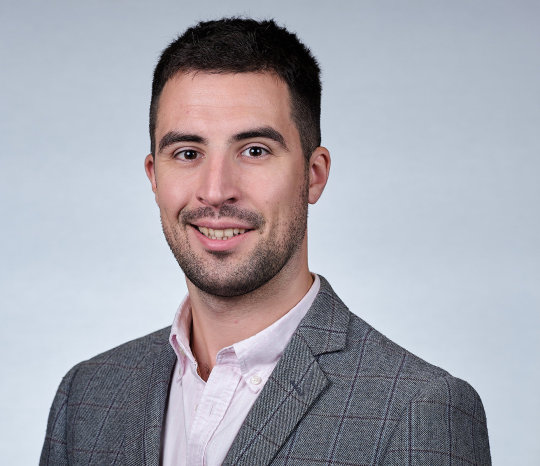
Ilija Rašović
Amanda Field Age: 25 Job: Development Engineer. Education: BEng Materials Science and Technology, University of Birmingham. Current project: Trying to finish my PhD on additive manufacturing of tungsten for nuclear fusion reactors. It’s challenging but worthwhile because the success of nuclear fusion would go a long way to solving the energy crisis. I’m working in additive manufacturing. Achievements: I have presented my work at international conferences. I was involved with an experimental parabolic flight campaign for the European Space Agency where we used a demonstrator device to 3D print metal in zero gravity. I came second in the IOM3 Young Persons Lecture Competition. Ultimate Goal: To keep working in additive manufacturing. I’d like to stay in R&D as you get such variety in your role and you have the potential to make significant improvements to a product or a technology, or design new ones yourself.
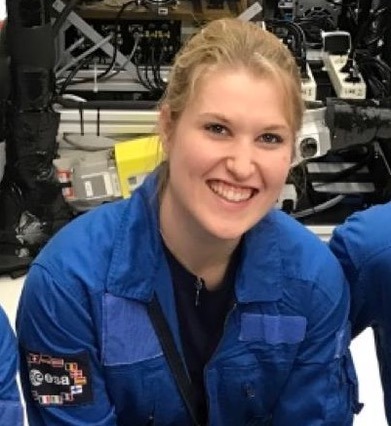
Amanda Field Image credit: Luke Carter
Jack Saunders Age: 25 Job: PhD Student in Materials Chemistry. Education: MChem with a year in industry, University of Manchester. Undertaking a PhD in Materials Chemistry, University of Manchester, in collaboration with AkzoNobel. Current project: To analyse the impact of different polymers on the corrosion protection afforded by emulsion paints. I aim to achieve this by synthesising and testing polymer’s corrosion performance. This is to better understand how polymer chemistry can affect the corrosion protection offered by the dried paint. Achievements: A First Class Master’s degree in chemistry. My PhD at the School of Materials at The University of Manchester. Awarded the President’s Doctoral Scholar Award. Presented my work at conferences such as the RSC’s MacroGroup YRM, Dublin, 2018. Won the regional Young Persons’ Lecture Competition this year. Ultimate goal: To develop my research and management skills in order to have my own research group in the field of polymer chemistry and colloid science.
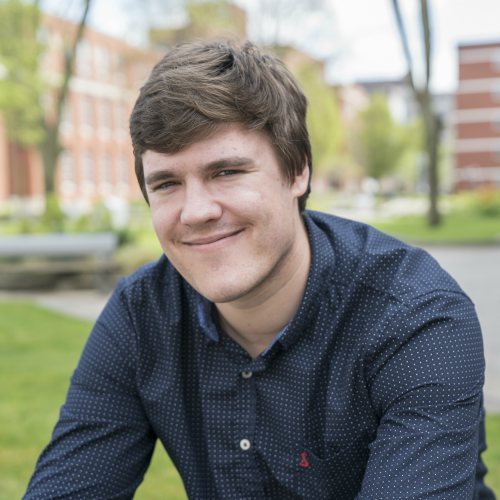
Jack Saunders Image credit: University of Manchester Megan McGregor Age: 25 Job: PhD Candidate at the Department of Materials Science & Metallurgy, University of Cambridge. Education: MSci in Natural Sciences, University of Cambridge, specialising in Materials Science. Current project: A PhD project investigating a new intermetallic alloy for commercial gas turbine engines. Specifically, trying to develop a novel coating material required to attach abrasives onto the end of rotating turbine blades, in pursuit of a more efficient sealing system. Achievements: I enjoy teaching in the department, and was recently awarded the Departmental Demonstrator Prize. I talked at the Cambridge Science Festival and the inaugural Cambridge Soapbox Science event. I will be representing the South Eastern Region in the final of the IOM3 Young Persons’ Lecture Competition this year, selected for an RCUK Public Policy Internship at the Government Office for Science in 2018, where I got to contribute to government policy. Ultimate goal: To see the material I am working on make it into a commercial gas turbine engine. I want to take my expertise in this area into industry, and be able to contribute to the development of the hybrid-electric aircraft sector.

Megan McGregor Image credit: Andrew Jeskins
Abigail Georgia Robinson Age: 22 Job: Geology student. Education: MGeol in Earth and Environmental Sciences, University of St Andrews, graduating in 2020. Current project: I will co-lead an expedition to the Lofdal Complex, Namibia, which hosts a suite of carbonatitic and silicic igneous rocks, some of which are enriched in heavy rare earth elements. I aim to integrate geological field data with geochemical and isotopic datasets to model the petrogenesis of the scientifically interesting igneous rocks. Achievements: I was awarded the prestigious Laidlaw Scholarship in Research and Leadership in 2018. This supported my field campaign in Armenia, to investigate the interplay between climate change, hydrology and medieval irrigation systems. I did a research placement at the Scottish Universities Environmental Research Centre where I learned to code in Python and used this to statistically investigate the geographical origin of lunar meteorites across the lunar surface. This work was included in Dr Marissa Tremblay’s published abstract and presentation at the 2019 Lunar and Planetary Science Conference, USA. Ultimate goal: I plan to embark on a PhD on the tectonically imposed planet-wide cycling of the volatile elements. I plan to be an active communicator promoting an understanding of geoscience and the global scale problems that we, the geoscientists, can work to solve.
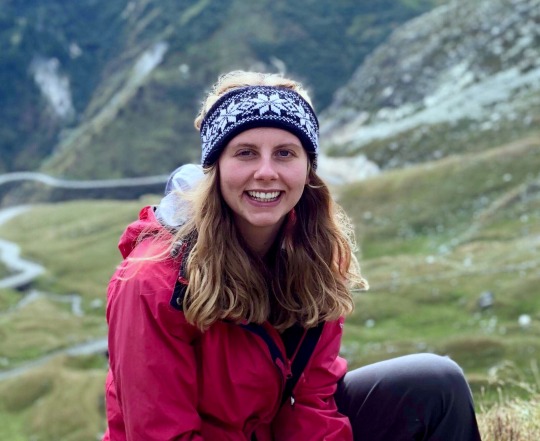
Abigail Robinson Image credit: Evan Margerum
Federica Rosaria Lisa Age: 24 Job: Technical Graduate at British Steel. Education: MChem Chemistry with Forensic Science with a year in industry, University of Leicester. Current project: A variety of research and development projects – one on understanding and reducing the factors that influence power and electrode consumption at the ladle arc furnaces in the secondary steelmaking process. Achievements: Graduated with a First Class Honours and secured a 12-month industrial placement and a place on a graduate programme. I succeeded in my secondary school exams after moving to a new continent and starting International School. Ultimate goal: To work for a sustainable discovery/development that will improve lives and I would like to lead a company. I would also like to promote the importance of education, support developing countries in the construction of more schools and strengthen the educational system.

Frederica Lisa Image credit: Johnny Gallagher Daniel Everington Age: 26 Job: Materials Technologist – Surface Engineering. Education: MEng Aerospace Engineering with a year in industry, University of Sheffield. Current project: Surface engineering at Rolls-Royce. I’m involved with different projects across the engine, including compressor sealing systems, hot end environmental protection and anti-seize coatings. Achievements: Developed a novel method to flow test ceramic filters used in the investment casting process. The technique contributed to a 3% improvement in casting yield and the reduced variation helps lower the amount of metal. Patents may be filed on the work. Ultimate goal: I’d like to work with academia to co-develop novel coatings/surface treatments. I enjoy the challenges that come with working on new technology as the answers can’t simply be found in a textbook.

Daniel Everington Image credit: Alistair Coast-Smith
Louise Gale Age: 28 Job: Materials Engineer at Rolls-Royce Plc. Education: MSci & MA in Natural Sciences, specialising in Materials Science, University of Cambridge. Current project: The development of ceramic matrix composites for introduction into aerospace gas turbine engines. My responsibilities include running mechanical testing programmes, supervising work at our university partners as well as the analysis and fractography of tested samples to elucidate damage mechanisms. Achievements: Completing the Rolls-Royce Graduate Scheme, including obtaining funding for an international placement in the Materials Testing Department in Berlin. I became Technical Lead of a £2.5mln project which was part of a government-funded programme to develop SiC/SiC ceramic matrix composites. I developed the £7mln, three-year materials development component to the follow on project that was approved in late 2017. Ultimate goal: To become an expert on ceramic and composite materials systems.

Louise Gale Image credit: Stephen Gale
James Grant Age: 24 Job: EngD student with TATA Steel and M2A, Materials and Manufacturing Academy. Education: School of Physics and Astronomy, Cardiff University, College of Engineering, Swansea University. Current project: Development of novel coating solutions for the improvement of pre/post heat treatment of carbon steel conveyance tubes. My project aims to reduce high-temperature oxidation caused by the normalising process. Achievements: I developed a novel anodisation system for fabricating alumina masks in the molecular beam epitaxy application. In addition to this, my placement with Merck successfully optimised electrophoretic fluids to further enhance the E-ink display technology. I’ve been competing in the 2019 IOM3 Young Persons Lecture Competition. Having won the SWMA heat and the South West Regional, presenting at the national final in May. Ultimate goal: To educate and encourage the next generation of students to take up STEM subjects. I hope I can engage and excite a younger audience about materials science and demonstrate the opportunities available in engineering.
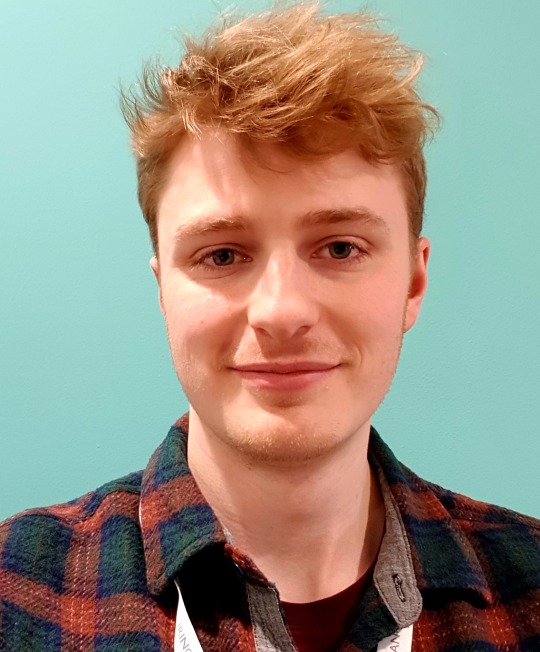
James Grant Image credit: James Grant
Vidya Chamundeswari Narasimhan Age: 28 years Job: Post-doctoral Research Fellow Department of Materials Science and Engineering, NTU. Education: PhD in Materials Engineering. Current project: Developing responsive nasogastric tubes for the elderly and using nature-derived biopolymers for biomedical applications. Achievements: Young Scientist Award conferred by VIWA in India, Title Winner of the IOM3 Young Persons’ World Lecture Competition 2017, Women in Engineering Travel Grant in 2018, Chair of the Young Scientists Forum at the European Materials Research Society conference in Poland 2018. Ultimate goal: To lead and manage a diverse team, foster interdisciplinary collaboration and offer R&D support for cutting edge research in the healthcare sector. I also want to contribute significantly towards mentoring the next generation of young girls towards pursuing exciting careers in STEM fields.
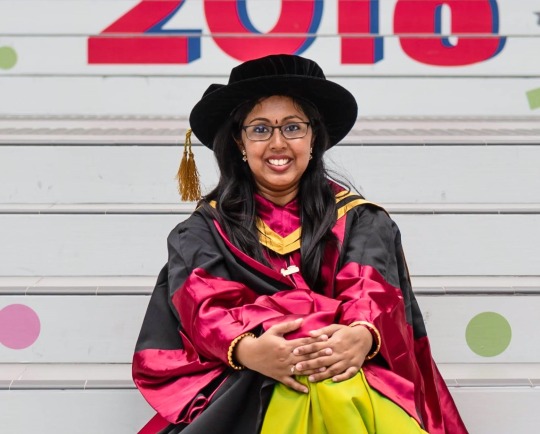
Vidya Chamundeswari Image credit: Dr Rohit Satish Frederick Cooper Age: 28 Job: Research Engineer and PhD student. Education: BEng with Honours, Swansea University. Current project: Microstructural and mechanical characterisation of flow formed F1E – a novel, maraging steel. Achievements: Used flow form to develop materials for detailed metallographic, micro-textural, and mechanical assessment. I run two small businesses, have an Associate Diploma from the National College of Music, and an Associate Fellowship of the Higher Education Academy and was appointed as a Yeoman of the Worshipful Company of Tin Plate Workers. Ultimate goal: To complete my current project and transfer a comprehensive mechanical property database detailing static and fatigue performance to a major engineering sponsor – to enable novel component manufacture. Further, I would like to use my experience to develop a career in public engagement or education.

Frederick Cooper Image credit: Lauren Ednie Photography
Robert Hoye Age: 28 Job: Royal Academy of Engineering Research Fellow. Education: PhD, Cambridge University, BE(Hons). Current project: I am looking at two areas that could accelerate the scale of photovoltaics. This makes an attractive technology for producing clean energy, especially in remote regions. Achievements: Developed a recombination contact to couple a metal-halide perovskite top-cell with an n-type silicon bottom cell, which lead to new design rules to identify promising classes of materials that could tolerate defects, and an all-inorganic device structure that led to 80% external quantum efficiency in solar cells. This went on display in the Deutsches Hygiene-Museum in Dresden, Germany. 2018 Young Engineer of the Year Award by the Royal Academy of Engineering, which also awarded me £500,000 to start an independent group at the University of Cambridge. European Forbes 30 under 30 list. Ultimate goal: To create new classes of defect-tolerant semiconductors that can be used as low-cost and efficient top-cells in tandem with silicon.
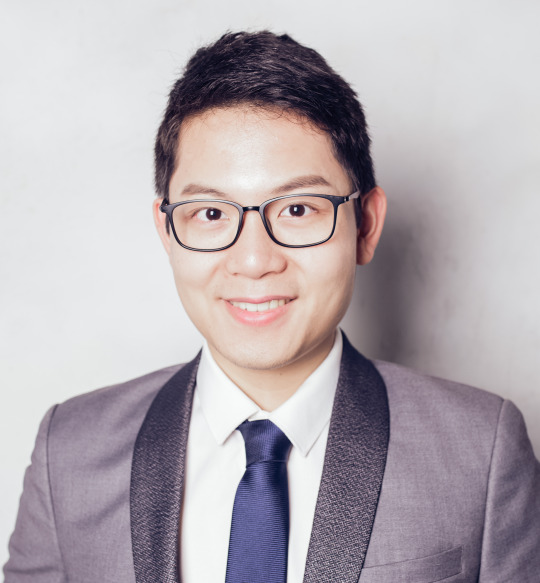
Robert Hoye Image credit: Zoe Chung
Matthew Wadge Age: 24 Job: PhD Researcher. Education: BSc(Hons) Biomedical Materials Science & PhD (ongoing), University Of Nottingham. Current project: Exploring novel formation and ion-exchange reactions of titanate surfaces for biomedical applications. Achievements: Achieved eight awards during my undergraduate degree including the Best Student Prize, Best Project Prize, and The Armourers and Brasiers’ Best Student Prize for achieving the highest project mark within the faculty. I have since won the Armourers and Brasiers’/TWI Best BSc/BEng Student of the Year Award, Best Oral Presentation Prize from the UK Society for Biomaterials Conference in 2018. Published my first journal paper during the first year of my PhD. I am one of the Nottingham coordinators for this year’s Pint of Science festival. Ultimate goal: To try and improve a patient’s quality of life, from improving fixation of hip stems for improved longevity, through to antibacterial surfaces for minimising infections. I aim to continue on into academia post PhD to share my experiences, and hopefully train the next generation of bioengineers and biomaterial scientists.
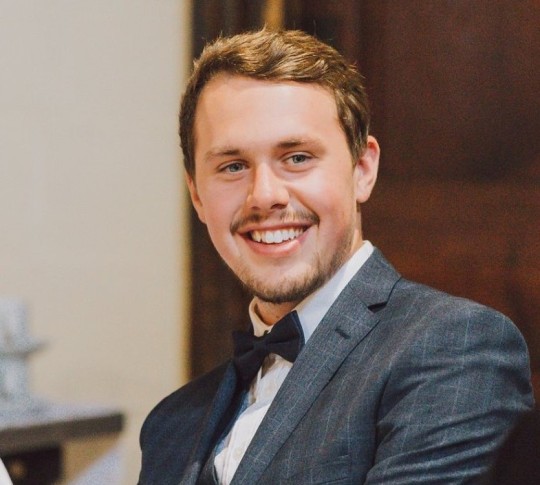
Matthew Wadge Image credit: Matthew James
#engineering#materials science#innovation#15 under 30#top#science#STEM#research#young#professionals#iom3
40 notes
·
View notes
Text
City Lab
Seminar 1: Rethinking the City.
Wednesday 9th December
3pm – 5pm
3pm – Introduction to The City Lab Seminars: John Byrne
3.10 – Alessandra Saviotti – The DPI Toolkit Explained
3.40 – Owen Griffiths – Landscapes of Resistance/Owen’s City Lab
4.10 – Jo Marsh - Ty Pawb, Wrexham’s Arts, Markets and Community Hub
Further Information:
In this first/opening City Lab Seminar we will be joined by three key thinkers and practitioners who are actively using the city as both a context and a tool for social change.
Each contributor will speak for 20 minutes, followed by a 10 minute opportunity for questions. There will also be time for further questions and discussions at the end of the presentations.
Ideas and themes that emerge from this first City Lab Seminar will be picked up again early next year (date to be announced) when all three panellists will join us for individual discussions/seminars as a first ‘open access’ point of the TPG shared module ‘Transdisciplinary Pracitce’.
Information on Speakers/Contributors:
Alessandra Saviotti (LJMU School of Art and Design / Asociación de Arte Útil)
Weblink: www.arte-util.org
Alessandra Saviotti Presentation: DPE Toolkit Explained - Alessandra will talk about the DPE's Toolkit section in particular on the idea of usership within the education context. Alessandra will address this question: is it possible for art to infiltrate the formal education environment in the form of a radical teaching approach that seeks to give a new shape to the existing configuration of the system, within the system itself?
Alessandra Saviotti Biography: Alessandra is a curator and educator who lives in Amsterdam. Alessandra is also a PhD candidate at the Liverpool John Moores University - School of Art and Design. Alessandra’s focus is on socially engaged art, collaborative practices and Arte Útil. Her work aims to realize projects where the public becomes a co-producer in the spirit of usership. Her reflection is taking into consideration collaborative processes according to the motto ‘cooperation is better than competition’. She is a co-founder of the art collective Aspra.mente (2006-2016), a group which focuses on the common definition of ‘work in progress’, seeking the contribution of operators in other fields than art for interdisciplinary projects that are free from time constraints. Alsessandra was part of the curatorial team of the 'Museum of Arte Útil' at the Van Abbemuseum (Eindhoven, NL) and since 2014 she has been collaborating with the Asociación de Arte Útil especially aiming at emancipating the usership around the Arte Útil Archive. She led online and offline seminars at the San Francisco Art Institute (2017), California College of the Arts (2017), SALT (2018), The Whitworth (2019), Chicago Architecture Biennial (2019), Accademia di Brera (2020), and she was the coordinator of the Escuela de Arte Útil at Yerba Buena Center for the Arts, San Francisco (US). She currently teaches at ArtEZ - International Master Artist Educator, Arnhem (NL) and she is a tutor at Accademia Unidee, Biella (IT). Since 2007 Alessandra has also been working in collaboration with several institutions such as SFMOMA (US), MAXXI, Rome (IT), Delfina Foundation, London (UK), Middlesbrough Institute of Modern Art (UK), Visible Project (IT), Manifesta 7 (IT), UNIDEE – Cittadellarte (IT), SALT (TR), Estudio Bruguera (USA) e Studio Grilli (BE). She is a 2013-14 van Eyck Akademie fellow, a 2015 Mondriaan Foundation grantee and a 2014 Demo Movin'Up grantee and she has been awarded an international mobility grant from i-Portunus – Creative Europe in 2019.
Owen Griffiths (Artist & Curator: Founder / Director Ways of Working- a locally engaged social enterprise). Owen is based in Wales.
Weblink: www.aboutreconnection.com
Owen Griffiths Presentation: Owen’s City Lab:
Owen will talk about his work as a series of landscapes of resistance - an emerging archipelago of collaborative project in civic spaces across the city of Swansea. Owen is interested in long term work, overlapping edges, social economic model santi gentrification and empowerment. His research is based around, collaboration, food and systems of land use and alternative ownership seeded through collaboration and social justice.
Owen Griffiths Biography:
Owen Griffiths is an artist, workshop leader and facilitator. Using participatory and collaborative processes, his socially engaged practice explores the possibilities of art to
create new frameworks, resources and systems. This takes many forms, but includes reclaiming and rethinking events, rituals and spaces of dialogue. Griffiths explores climate, landscape, urbanism, social justice, food systems and pedagogy, creating projects and events that prepare us for the gentle work of the future.
He is interested in working locally and in long term dialogue with communities and projects. These long-term dialogues make a case for slowing down time, rethinking the expectations around participation to model new collaborative methods which raise questions around equity, empowerment and sustainability.
In 2020 Griffiths developed Ways of Working a new community participation platform and company in order to work in ways he feels are urgent; speaking to climate crisis, localism and radical collaborative projects.
Jo Marsh (Creative Director at Ty Pawb), Wrexham’s Arts, Markets and Community Hub.
Weblink: https://hes32-ctp.trendmicro.com:443/wis/clicktime/v1/query?url=https%3a%2f%2fwww.typawb.wales&umid=26848098-e77f-414c-a12b-2449a4ca4efe&auth=768f192bba830b801fed4f40fb360f4d1374fa7c-d5eaefcbd2ec131e42ae96d121134efa26351191 and/or https://www.theguardian.com/artanddesign/2018/sep/01/ty-pawb-review-art-gallery-everybodys-house-wrexham-market
Jo Marsh Biography:
After graduating in 2009 Jo worked as a freelance artist for a few years, this included lots of gallery education work in Wales, some in France and at the Design Museum in London. In 2011 Jo won the Leeds based Woolgather Art Prize, with my project ‘With Love From The Artist’ that had developed from my side hustle as an itinerant market trader https://hes32-ctp.trendmicro.com:443/wis/clicktime/v1/query?url=www.withlovefromtheartist.com&umid=26848098-e77f-414c-a12b-2449a4ca4efe&auth=768f192bba830b801fed4f40fb360f4d1374fa7c-514d3850b6845bcd75526d65f4321d8d79885aa5.
In 2013-14 Jo was funded by Arts Council Wales to build and tour a travelling gallery called WanderBox, offering residencies to artists in a wide variety of settings and locations https://hes32-ctp.trendmicro.com:443/wis/clicktime/v1/query?url=https%3a%2f%2fwww.axisweb.org%2fp%2fjomarsh%2fworkset%2f213293%2dwanderbox%2f&umid=26848098-e77f-414c-a12b-2449a4ca4efe&auth=768f192bba830b801fed4f40fb360f4d1374fa7c-5710c37b68c29a33d55e90625a283baa14a13fb9
In late 2014 Jo became the Learning and Engagement Officer for Oriel Wrecsam, leading the off-site engagement programme for three years as plans for a new arts and markets development unfolded. This off-site programme included working with young people to build a full sized Shepherd’s Hut, and working with local people to establish a makers group that met regularly and adventured round the county.
In 2017 Jo was appointed Creative Director at Ty Pawb (formerly Oriel Wrecsam and the People’s Market, Wrexham). Since then Jo have been leading a programme of exhibitions and projects that grow out of local connections, and respond to local urgencies. So far this has included building a temporary adventure playground in one of the galleries (complete with 16 tonnes of sand!), working with members from our resident mental health charity to design and manufacture lamps for sale, and establishing a nascent rooftop garden on our multistory carpark.
1 note
·
View note
Text
The Interlace Project - What is it and meet the volunteers
On the 15th of February this year I sat in on a workshop held at the Museum and Art Gallery as part of the Interlace Project. With the buzz of Pangolin Day happening in the World Collections gallery, I got to see a small group of museum volunteers getting to grips with the weaving work they were undertaking as part of the project, which will eventually form an art installation to go into the new Museum of Making. This was being led by artist Toni Buckby and museum volunteer Ruth Winterbottom. Scroll further down to find out more about the wonderful volunteers involved.
More recently I had the pleasure of talking again with Toni, and asked her some more in-depth questions about Interlace.
Please introduce yourself.
“My name is Toni Buckby and I'm an artist and PhD researcher based in Sheffield. My work spans the seemingly diverse but oddly related fields of textiles, electronics and computer art. I specialise in hand embroidery, with a particular focus on the 16th Century technique of blackwork, and the creation of experimental interactive electronics. I also spin, weave, draw, code, laser cut, 3D print... I spend most of my time attempting to get impractical ideas to function! I love to collaborate, so I often work with other artists on projects, as well as running public workshops and making a lot of my work available online for others to use. I see a parallel between the making of textiles and the making of digital work – both are logical processes of building complex structures through simple components. There is certainly a conceptual similarity, but I also create hybrid works, like embedding electronics into fabric or creating computer simulations based on textile techniques. I’m quite playful in my approach to my work – I take great delight in mashing (often disparate) materials and ideas together to see what happens - it’s why I like to collaborate so much. There's joy in the attempt to get something working (or not!).”

Image: Toni introducing museum volunteers to the bare cocoon bodies they will be weaving onto

Image: The wooden structures are modelled on silk moth cocoons, these being intrinsic to the silk weaving that took place at the Museum of Making site during the 18th Century. ©Toni Buckby
What is the Interlace Project?
“The Interlace Project began in 2017, when I was invited by Derby Museums to design and produce simple weaving looms that could be manufactured in the maker space at The Silk Mill. All the loom designs and instructions for how to use them were made available for free online (click here), and I've also run many public workshops in the basics of weaving using the looms. Inspired by the building's history as a silk spinning mill, I have now designed a large interactive textile sculpture, which is being made in collaboration with museum volunteers. The sculpture consists of nine woven silk moth cocoon shapes that have fibre optic light strands running through them; all being made by museum volunteer Ruth Winterbottom and her team of amazingly skilled volunteer weavers. The pattern of the lights will be programmed by visitors using punch cards (similar to the ones that were used to create weaving patterns on Jacquard looms in the 19th Century), and the colours will be controlled by touching small woven panels, a mixture of different fibres plus rows of conductive metal thread, that have been made by over 100 volunteers during several group workshops.”
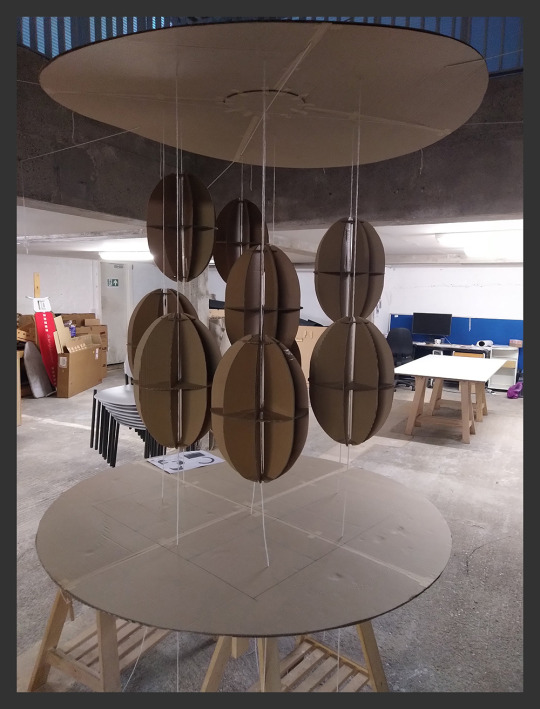
Image: An early cardboard mock-up gives an indication of what the installation will look like. ©Toni Buckby

Image: An example of the fabric and metal touch panels that will form the interactive controls for the installation. ©Toni Buckby
What drew you towards wanting to work with Derby Museums and the Museum of Making?
“Two of my key interests as an artist are showing and sharing the processes of making. I love the fact that Derby’s Museum of Making will celebrate manufacturing processes as well as getting people involved through its events, workshops, volunteer programme and maker space. I've met so many brilliant, enthusiastic people over the course of developing The Interlace Project and it's been a real pleasure working with an organisation that has such similar interests.”

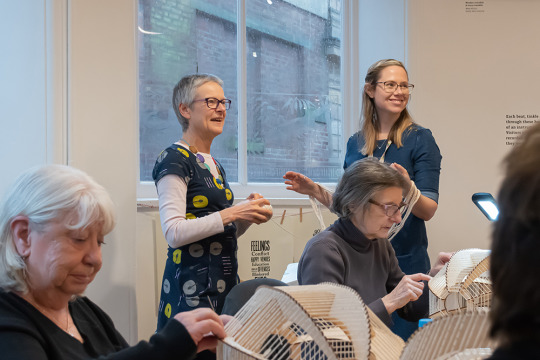
Are there any thoughts or feelings you would like Interlace to provoke?
“I think, firstly, I hope visitors to the museum will be delighted by the piece - it's very playful! Secondly, I hope that people will take the time to appreciate the effort and skill of the volunteers who have made the work. I've been genuinely blown away by the quality and creativity of all those who have contributed so far - both the experienced weavers and those who had never woven before getting involved in the project. Everyone should be immensely proud of their work!”

Image: One of the cocoons approaching completion, fibre-optic and organic threads interspersed

Image: An example cocoon with the fibres illuminated. ©Toni Buckby
How will people be able to get involved with the project?
“Visitors to the museum will be able to interact with the sculptural installation by programming the light patterns and colours. Additionally, the online resources (designs and instructions) are available on the projects Instructables site, if people would like to have a go at weaving themselves. Finally, as the interactive woven panels are going to need to be replaced every few months, we are also (hopefully) going to have more workshops in future where people can have a go at weaving their own panel, which will then become (temporally) part of the installation”.


It will be very exciting to see this artwork in action when it takes its place in the Museum of Making, and to see how it will very physically link the first use of Derby’s Silk Mill as a factory with it’s new iteration as the Museum of Making, showcasing our regions industrial heritage and innovative future.
Check back for more posts from Oliver!
Interlace Volunteer Responses
We asked some of our wonderful volunteers about their experience on the Interlace project and here’s what they had to say.
Ruth

We asked Ruth why she decided to start volunteering with Derby Museums:
‘I enjoy art, heritage and involvement with people and always relished my visits to the Museum. When we moved into an apartment next to the Silk Mill, it was a no-brainer!’
What about Ruth’s involvement on the Interlace project?:
‘I’ve been working with Toni Buckby to help realise, with a team of local skilled craftspeople, her vision for a textile installation in the new Museum of Making. Toni references the silk cocoon and weaving in her computer-controlled light display.’
Ruth shared what she has got from being involved in the Interlace project:
‘It has been a pleasure and rare privilege to be part of such a professional textile project! I’ve revisited old skills, learned new ones and interacted with lovely people, not least Toni herself. She is a wonderful artist and generous person. It’s humbling to be part of the start of a new Museum’s journey.’
Barbara

Barbara responded to a Derby Museums call out asking for volunteers for a weaving project; she said:
‘Weaving sounded right up my street! I love designing and making things particularly with textiles of all types.’
Just before the lockdown Barbara was able to take home a piece of the project to work on:
‘It took many hours of peaceful meditative activity which was marvellous occupation in the circumstances that was very good for me; also providing a topic of conversation with friends and family that was positive and different from the constant Covid coverage and shared anxious feelings of being separated from much loved and familiar people and activities’.
Hazel

Hazel met volunteer project coordinator Ruth at a Derbyshire Guild of Weavers, Spinners & Dyers meeting where Ruth presented Toni Buckby’s concept:
‘I jumped at the chance [to be involved] - what a great idea and to be part of the museum redevelopment.’
Hazel has been weaving one of the cocoons:
‘This was something new for me and a bit of a challenge, but after over 60 hours of weaving I’m really pleased with the results [and have got] a huge sense of satisfaction from the weaving process and immense pride in what I’ve achieved. I can’t wait to see it installed.’
Sandra

Sandra joined as a volunteer through the Derbyshire Guild of Weavers, Spinners and Dyers and has woven one of the cocoons:
‘As the silk mill was an important, past Derby industry I felt it was relevant, as a member of The Derbyshire Guild, to represent the group by using my weaving skills on a piece of the installation. It has been a great opportunity to work on a creative form using materials, especially the lighting, which I wouldn’t normally have used.’
Bibi

Bibi explains why she got involved with the project:
‘The idea of weaving a cocoon was irresistible to me. I am also excited about the development of the Museum of Making and what it is going to offer to the community.’
However it wasn’t without its challenges:
‘This cocoon was a challenge. The design is so good and the whole exercise was very rewarding in its outcome. I am delighted to be part of the project as a group effort. I am looking forward to seeing them all illuminated.’
Joan

Joan, as a weaver, was interested in helping with this project:
‘[I have] never undertaken a project of this sort before. I certainly found this an interesting challenge with the optical fibre being a difficult addition and always at the back of my mind the fact that my work was going to be on public display.’
Thank you to all of our volunteers who are helping to make the Museum of Making, we really wouldn’t be able to do it without you!
2 notes
·
View notes